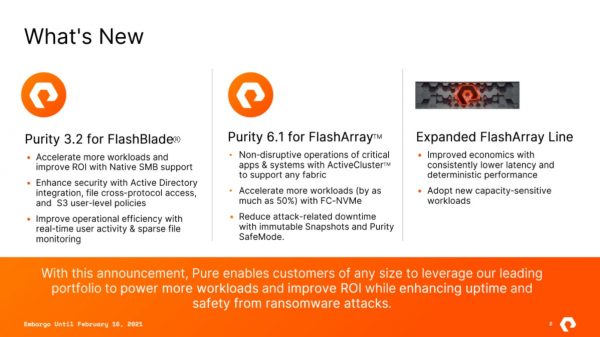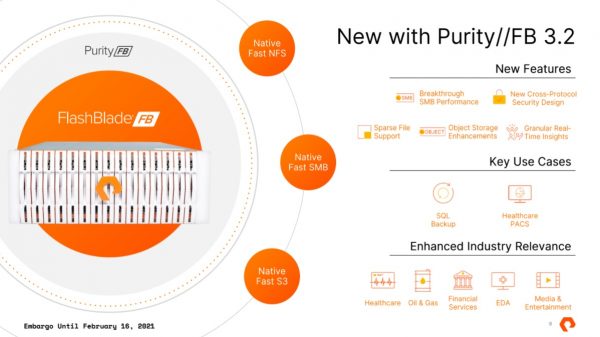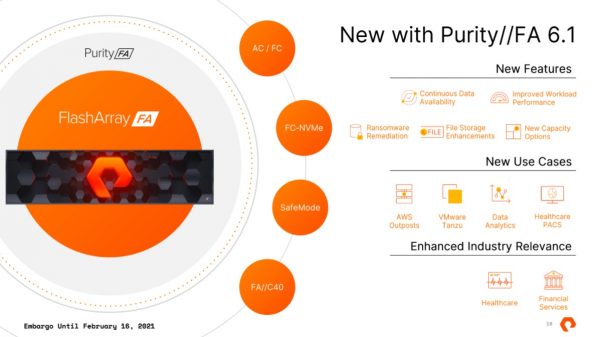Pure Storage With Purity Software and Third Gen Capacity Optimized Flash Platform
Unifying file support and ransomware protection across FlashBlade and FlashArray
This is a Press Release edited by StorageNewsletter.com on February 19, 2021 at 2:24 pmPure Storage, Inc. announced enhancements to its unified storage portfolio, extending its enterprise storage market by expanding into new markets and verticals.
The updates to the Purity software for FlashBlade and FlashArray accelerate Windows applications, deliver ransomware protection across file, block and native cloud-based apps, and make hybrid storage for both departmental and data center workloads obsolete with a third gen FlashArray//C all-QLC platform.
The latest updates, delivered through Pure’s Evergreen subscription model, further the company’s vision for a modern data experience.
Key enhancements are:
Comprehensive File Portfolio Redefines Performance and Simplicity Across Ever-Broadening Use Cases
- This news extends FlashBlade with new native SMB support. This provides simplicity and multi-dimensional performance for very high throughput and IO/s with low latency to support multiple workloads simultaneously, files of any size, and sequential or random I/O access. Customers can accelerate Windows applications with a set of existing data services, including replication, File System Rollback, and SafeMode Snapshots for rapid ransomware recovery. Validated solutions include healthcare PACS applications and SQL Server Backup at speeds higher than 1TB/min for SQL farms that demand fast backup and recovery.
- FlashBlade’s new Cross-Protocol File Security design allows access control interoperability between SMB and NFS users while preserving access control lists for both in addition to complying with federal security mandates.
- FlashArray’s scale-up architecture balances performance and capacity, delivering operational file services for VDI, file server consolidation, user home directories, and file sharing. File capabilities in FlashArray enhance the value of inherent features such as de-dupe and compression.
Comprehensive Ransomware Protection and Security across File, Block, and Cloud-Based Apps
- FlashBlade and FlashArray are now both strengthened by SafeMode snapshots, delivering a portfolio of protection tools to ensure data is always safe and recoverable in seconds. Immutable snapshots and Policy-based Retention protect companies against the risk of lost revenues, ransom payments, and brand damage associated with ransomware attacks.
- FlashBlade, the industry-defining Unified Fast File and Object (UFFO) platform, provides enhanced object security with S3 simple user policies, enabling access control at the user level. Granular, user-level performance monitoring meets a critical requirement for real-time visibility into the most active users and unified APIs/SDK improves the automation experience across FlashBlade, FlashArray, and Pure1 with unified REST APIs and Python SDK.
Improved Disaster Recovery with ActiveCluster over Fibre Channel: ActiveCluster delivers stretch clustering solutions for critical applications over any fabric. ActiveCluster is integrated with Pure1 Cloud Mediator, which removes the need to manage a cumbersome third-site witness and enables a third recovery site to be added anywhere in the world.
Tier-1 Application Performance: With NVMe-oF, the company continues to accelerate its leadership as it delivers an all-NVMe architecture for flash, Direct Memory Modules, replication, and now support for both NVMe over FC and Ethernet. Support for NVMe can reduce application latency by up to 50% by reducing latencies to hundreds of microseconds.
Third-Gen of FlashArray//C Makes Hybrid Storage Obsolete: The new releases of FlashArray//C40 and FlashArray//C60 demonstrate Pure’s innovation and extend a flash leadership story. While other vendors struggle to bring QLC to market, FlashArray//C can now replace legacy disks in deployments of all sizes, ranging from departmental to data center consolidation.
“Pure is named a leader in the recent Gartner Magic Quadrant for Primary Storage Arrays and positioned highest and farthest in both vectors because we are chipping away at the complexity baked into legacy storage that is simply not designed for the digital age. Our vision for a Modern Data Experience empowers organizations to innovate by providing a dynamic, cloud-based storage experience that is flexible, on-demand, and delivered as code,” said Ajay Singh, chief product officer.
Long-Standing Pure Portfolio Customer: Royal Bank of Canada
“Pure is always one step ahead of the market and the latest updates to the Purity software across FlashBlade and FlashArray show that we’ve made the right choice for our business. With Pure, we have been able to achieve 100% uptime in our environment, which is critical to our banking operations,” said Antonio Puccio, director of SAN storage, Royal Bank of Canada.
Only Pure’s subscription services come ready with all-inclusive licensing, allowing customers to adopt new innovations without disruption, downtime, or the requirement to re-buy capacity. As part of the Evergreen Storage subscription model, these new features require no additional licenses or support costs and ensure zero added complexity.
Pure also announced file replication capabilities on FlashArray with Komprise.
New features in Purity for FlashArray are available and in 1Q21 for Purity for FlashBlade.
Comments
This Pure's portfolio update is a strategic step covering FlashArray and FlashBlade with their respective Purity OS flavors.
Choosing to announce the refresh of its 2 products at the same time is anr indicator towards the need of convergence both in terms of use cases, users and technologies. This announcement shows that again differences come from software.
The company accelerates towards unified storage with FlashArray and FlashBlade coming from different horizons originally. This new market iteration confirms that the U3 - Unified, Universal and Ubiquitous - storage model we initiated several years ago is a reality for a few months both in terms of market and users needs and real product offerings. The Pure Storage Modern Data Experience is a with this U3 market dynamic.
With various Purity iterations on both side of the portfolio, products teams finally deliver 2 unified products that have NAS protocols in common: FlashArray is BF (Block + File) and FlashBlade is FO (File + Object). The FlashBlade team even reused what other storage vendors promoted a few years ago with UFO being more subtle now with UFFO.

First, FlashBlade receives the 3.2 minor release but with 2 key features we insisted on a few times in the past:
- SMB of course a very important access method when a vendor promotes a file sharing solution, and
- The fundamental cross-protocol access meaning the access to the same content via difference access methods. This last extension is critical as users don't understand the need of data duplication due to access protocols limitations thus impacting cost and reducing available space. Now this is solved and fills the gap with some competitors who already deliver this. We'll monitor that capability in the next few months.

Clearly the vendor strengthens its unstructured data platform already recognized as a leader in both Coldago Research Map 2020 File Storage and Object Storage and also in Gartner Magic Quadrant 2020 for Distributed File Systems and Object Storage.
The product is promoted to address very specific use cases and plays in secondary storage dedicated to data protection. Multiplying use cases especially with SMB now and multi-access should invite Pure Storage to push FlashBlade in more horizontal way.
Second, FlashArray, originally a pure block array, has morphed over time to an unified storage platform as well in 2 phases. The file storage engine was first promoted with Purity Run with Purity 5.0 (in fact introduced with the Purity 4.9.0 release) and second with the integration of Compuverde software as FlashArray File Services.
With that acquisition, there are 2 key questions for Pure's product strategy team:
- Before the acquisition, Compuverde was an unified storage software able to expose S3 and even Swift object APIs. Does it mean that one of the next Purity iteration could be this addition delivering the 3 access methods families - block, file and object? It won't prevent users to acquire FlashBlade but for ones who already have FlashArray deployed and need a remote access it makes sense to cover file side by S3. And even if the development team won't add that extension with some Compuverde element, what about adding MinIO like Qumulo, Pavilion Data, Robin.IO or iXsystems do. And at the end, users can download MinIO Gateway for NAS to build a full U3 storage platform.
- With a clear multicloud strategy and real needs for users, we understand the block flavor of FlashArray is available in the cloud via Cloud Block Store. Beyond FlashBlade integration with AWS Outposts announced a few months ago, what about file access in the cloud with a Compuverde Purified engine available on AWS, Azure and GCP marketplace?
This FlashArray Purity release is also the opportunity to announce a new iteration of Komprise partnership - the first one was around NAS migration for FlashBlade and FlashArray File Services - with the integration of the asynchronous replication/copy engine of Komprise Elastic Data Migration. This new level of synergy shows progress but invites us to wonder why there is some confusion or disconnect between the announcement and the Komprise page as it is shown that Komprise replication is new for FlashArray. If you read the FlashArray Solution Brief on that page it is dated of June 2020 so 8 months ago. So what is new? or the info on Komprise brief is just wrong?

ActiveCluster shows progress on the BCDR side and we expect soon a 3 sites model with a sync mode between A and B sites and then a async copy between same primary A site to a remote C. It will also make sense to think about a cascading model where B is doing the remote async copy to C instead of A freeing completely A.
On the connectivity side, Pure continues to iterate with NVMe-oF with FC and Ethernet and next quarters will be interesting to watch.
The battle is clearly on as well between full flash players, some addressing market needs with one product whatever the tier is and other positioning distinct offerings for different tiers but obviously, both categories consider QLC flash to beat HDD and hybrid model.














 Subscribe to our free daily newsletter
Subscribe to our free daily newsletter


